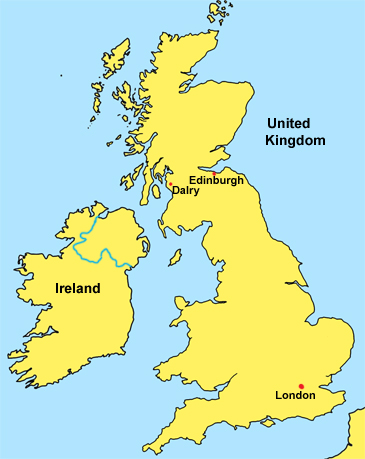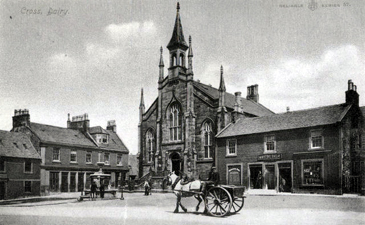 Chris Korte's New Zealand Genealogy Project
Chris Korte's New Zealand Genealogy Project
Dalry, Ayrshire, Scotland
About page
This page has some information about the small town of Dalry in North Ayrshire, Scotland. Ann Leith (1838-1922), also known as Ann Logan, was born in Dalry. Her mother, Margaret Boyle, was born and died in Dalry.
If you can provide additional information, or corrections, please contact (see Info menu).
Dalry
The name Dalry comes from the Gaelic Dail-righ, which signifies the "King's Valley". The valley, as the name inplies, is the distinguishing feature of the parish. The rich peaty soil is fertile and excellent for agriculture.
Today Dalry has a population of around 5,500 people. The town location is shown on the map below and there is a photo of the town at the bottom of page.
Up until 1800 the village of Dalry had only about 100 people. The opening of numerous limeworks, and a number of coal pits from the 1840s, wholly changed the character of the parish of Dalry. It became an increasingly industrial area peppered with mines to provide the ore and coal to fuel the blast furnaces at the various iron works.
This once industrial town, like many such towns in this area of Scotland has seen a sharp decline of traditional industry. In addition to coal mining, iron stone mining and textile manufacturing the town also had clay mines to be used in the areas various brickworks.
The distinctive Parish Church was built between 1871 and 1873 to serve the increased population associated with industrial growth. The nearby Hall was built in In 1889.

19th Century Dalry
The following transcript was provided by Keith Muirhead from the Sunshine Coast of Queensland. It was published in 1837 in Ayrshire Directory by Pigot and Co.
Dalry is a small town, in the parish of its name, and district of Cunningham; 69 miles w by s of Edinburgh, 25 sw of Glasgow, 16¼ ssw of Paisley, 5 sw of Beith, 4 n of Kilwinning and 7 n by e of Saltcoats; pleasantly situate on a rising ground, surrounded by the rivers Caaf, Rye and Garnock, which run in different directions so near the village, as to give it, when the streams are swelled with rain, the appearance of an island.
The branches of manufacture existing in the town and parish are those of cotton and carpet yarn with silk and harness weaving, in which many of both sexes are employed; while a considerable number of females are occupied in sewing and embroidering, usually denominated "Ayrshire needlework" for the Glasgow and Paisley manufacturers. The dressing and spinning of flax is likewise carried on to some extent, and lime and coal abound in the neighbourhood.
At the beginning of the last century, Dalry village contained only about six dwellings, and a population not exceeding 100; at present there are about 1,000 inhabitants, and the town consists of five streets, three of which diverge from a centre forming a small square; many of the houses are well built, and the shops are neat. There are several public houses for the accommodation of travelers, and two which belong to the grade of Inns; the one called the "Crown" is the principal. The town is lighted by gas, by a Company formed in 1834. There are three public libraries in the parish, viz, the "Dalry Library", the "Dalry Church Library" and the "United Secession Library".
At Loansbrea is a reasonably fine spring of water; and from a situation near the church is seen, to the west, a beautiful natural cascade, which has a curious and extraordinary appearance during the continuance of frost. At Auchenflech, on the estate of Blair, two miles from Dalry, is a cave, evidently the work of nature, and well deserving the examination of visitors to the district; it is about 183 feet in length, and from 5 to 12 in height; the roof is encrusted with petrefactions, and over the entrance projects a vast rock, 30 feet by 27; its exterior resembles Gothic arched work; near the middle it expands into a spacious chamber, 35 feet long by 12 broad, and 12 feet in height; in former times popular superstition peopled it with elves - it accordingly received the appellation of "elf-house"; in later days, under the arbitrary and treacherous reign of Charles II., it afforded a refuge to the covenanters of this parish from the violence of their infuriated persecutors.
 |  |
| Parish Church and Hall, Dalry | The Cross, Dalry |
The two images are from Photographs of Old Dalry. There are numerous other photos of Dalry on the site.
Page last updated on 24 July 2018.







